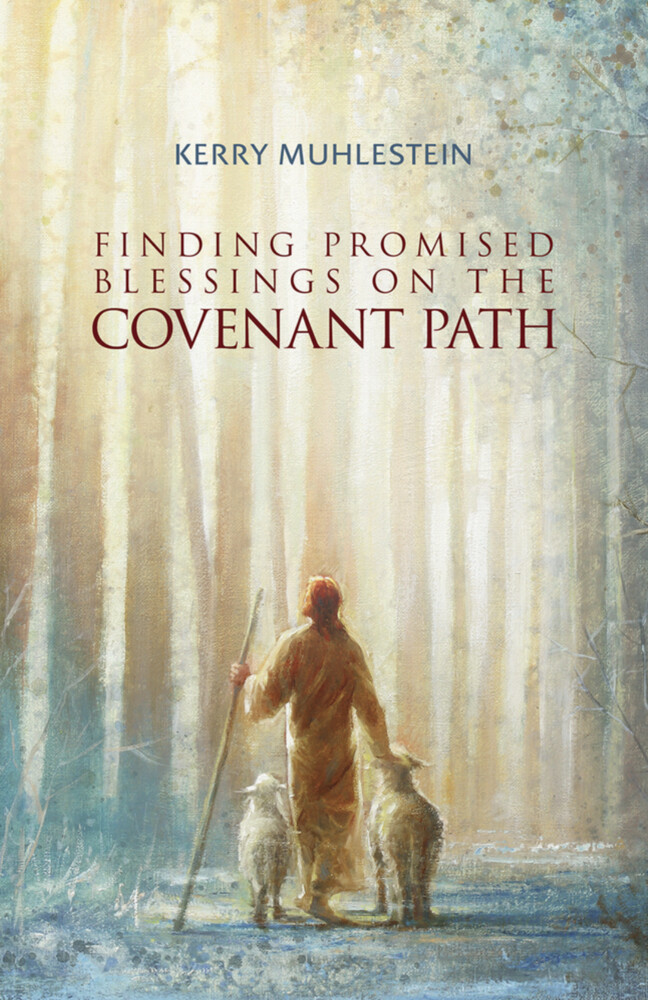With such amazing promises attached to it, no wonder there is an increased and urgent emphasis on the spiritual significance of the covenant path. This has clearly been reiterated by President Nelson, who pleads with us to “keep on the covenant path. Your commitment to follow the Savior by making covenants with Him and then keeping those covenants will open the door to every spiritual blessing and privilege available to men, women, and children everywhere,” including “the greatest gift of God—that of eternal life.”1
But what exactly is the covenant path of which our leaders continually speak, and how do we know whether we are on it?
To answer this, we should first explore the metaphor of a “path.” The scriptures often use a path, or something similar, to describe the way back to God, which makes perfect sense. Our journey to return to God is not as much about arriving in a physical location as it is about changing our natures. Yet, our brains most easily conceive of any kind of journey in terms of getting from point A to point B.
Thus, we talk about a strait and narrow path that leads us to God, and about an iron rod that helps us stay on that path. We speak of shepherds and guides who lead us through green pastures and help us come to a safe sheepfold. We talk about gates that both lead us to the right path and control access to it. We talk about a highway being cast upon which we can travel.
Why Covenants?
But why are covenants so integrally tied to our journey to regain God’s presence? While I am sure there are many answers to this question, here we will discuss only a few.
First, this kind of forged bond creates the kind of relationship with God that both inspires us to keep moving toward Him and also allows Him to bless us with the power we need to continue that journey.
Second, when we receive the power—or blessings—we need to continue our journey, if we receive them within a covenant context, then we can more easily keep in mind that these blessings are from God. That, in turn, helps us to keep moving toward God rather than mistakenly believing that these blessings are the results of our own efforts, a prideful viewpoint that would inevitably lead us away from God. Avoiding this kind of pride is a never-ending struggle for all of God’s children, but covenants can be a key component in avoiding pride.
Third, covenants contain clear stipulations that provide measurable waypoints, or markers, allowing us to assess whether we are still on the path.
Compasses and Cairns
So, what are the markers that help us recognize whether we are still on the path? When experienced hikers travel along trails that are new to them, they often use both a GPS unit to help them know they are on the path, and they look for cairns, or piles of rocks, that those who have already traveled that path have created to mark the trail for others. God provides us with spiritual GPS markers and cairns as we travel the covenant path. We are already familiar with them; we just need to come to recognize them as the trail markers they are.
As Elder Bednar teaches, “Gospel covenants and ordinances operate in our lives much like a compass. A compass is a device used to indicate the cardinal directions of north, south, east, and west for purposes of navigation and geographic orientation. In a similar way, our covenants and ordinances point us to and help us always remember our connection with the Lord Jesus Christ as we progress along the covenant path.”2
The beginning of the path is clearly marked. As you already know, we enter it through a gate—baptism. But have we really considered how effective that gateway is? It is when we are baptized that we enter into the Abrahamic—or new and everlasting—covenant. Remember that the covenant path is a way of holiness, and only those who are holy, or more like God and less like the world, can travel on that path.
The way to move forward is marked by the terms of the covenant. We promise that we will obey God’s commands and bear witness of Him. Above all else, we promise to love God and draw ever closer to Him and to love and take care of each other. The covenant path consists of our fulfilling our promised obligations.
If we want to know whether we are on this path, we need only ask ourselves two questions:
- Am I striving to do what I promised God I would do?
- Am I working toward the next step—or covenant—on the path?
In other words, are we striving to live our lives according to the gospel, and are we loving God and each other? It does not mean that we are perfect in our obedience—no one is. It means that we are striving to live the right way. If we are trying to obey and love, then we are on the path. If we are working toward making covenants in the temple, which is the next step on the path after baptism, then we are safely on the path. If we are doing things that would prevent us from going to the temple, then we are not on the path.
The next step, or waypoint, in the path, is to undertake these solemn promises in the temple. There we are washed and anointed,3 which conveys symbolism similar to that of baptism; for we wash away the sins of the world and are anointed to become something more than we were beforehand, which allows us to become even more godly. This in turn makes us capable of an even closer relationship with Him.
If we do indeed keep our covenants, we can move toward the next step on the path, which is to be sealed in the temple. Temple weddings, or being sealed together as a family, are clearly about the Abrahamic covenant. This is especially true in terms of having numerous posterity. As President Nelson teaches, “Think of it! A marriage made in the temple is tied directly to that Abrahamic covenant. In the temple, a couple is introduced to all the blessings reserved for the faithful posterity of Abraham, Isaac, and Jacob.”4
▶ You may also like: What are the 5 covenants made in the temple endowment?
Markers
One interesting marker of whether or not we are on the path is whether we are “peculiar” (Exodus 19:5), or more like God and less like the world. In other words, the covenant path is not the path the world takes, and often, those who are on the path will feel a tension with the world. Some of this tension will come because the world wants us to think of ourselves differently than God does. As President Nelson has recently emphasized, our primary identities should be:
- we are children of God,
- we are children of the covenant, and
- we are disciples of Christ and members of His restored Church.
That is not how the world thinks of us. When we find ourselves thinking of other self-identities more than these, we should recognize those thoughts as a warning that we are starting to stray from the covenant path. If we are filtering all other ways we think of ourselves through these identities, we can take that as a sign that we are on the path.
Following prophets, both ancient and modern, is an important marker on the covenant path. When we combine what we have learned in the scriptures about the covenant with our desire to stay on the covenant path, we find another powerful tool for helping us make sure we remain on the path. As we recognize when prophets in the scriptures are talking about the covenant, and when we recognize that we, too, are covenant Israel, we will find that these prophets offer us dozens upon dozens of cairns to help us make sure we are on the path. All we have to do is take a moment to ask ourselves if we are on the right side of the waypoints they have laid out for us.
Another indicator that we are on the covenant path is whether we find ourselves feeling a love for others. Creating a closer relationship with each other is also part of the covenant. As President Jean B. Bingham teaches, “As [people] who make and keep covenants with God, we share spiritual bonds that help us meet the challenges of our day and prepare us for the Second Coming of Jesus Christ.”5 Feeling a love for others and a desire to strengthen bonds with them and help and uplift them is a cairn, or marker, that can help us recognize we are still on the path.
Having a desire to end conflict and create more peace and love in our relationships, as President Nelson has asked us to do, is another waypoint that indicates we are on the covenant path of loving each other.6 “The greatest joy you will ever experience is when you are consumed with love for God and for all His children. Loving God more than anyone or anything else is the condition that brings true peace, comfort, confidence, and joy.”7
Have I Done Enough?
The covenant path is not about whether we are enough or do enough. It is a path about what we can become in Christ. It is a path of love. The things we do and the things we become flow from the love we feel for others, the love we feel from others, and the relationships created by that love, most especially the enabling relationship with Christ that creates a new you.
Yes, the covenant path is a path of love.8 It is also a path of incredible, unimaginable blessings. How blessed we are to be children of an Almighty Being who loves us and is willing to bind Himself to us! How fortunate we are to live in a day where we have modern prophets whom God is asking to remind us of this bond! How wonderful that the ordinances and covenants are available to us in these, the last days! How grateful we should be that the path that binds us to God is so clearly marked and readily accessible! Above all, how sublime it is that God has established this binding and edifying covenant with us and then sent His Son, who makes it possible for the covenant to be fulfilled!
▶ You may also like: 4 topics to discuss with a loved one to help them be ready for the temple
Finding Promised Blessings on the Covenant Path
Notes
- Russell M. Nelson, “As We Go Forward Together,” Ensign or Liahona, April 2018, 7.
- David A. Bednar, “But We Heeded Them Not,” Liahona, May 2022, 15.
- See Joseph Smith, “History, 1838–1856, volume C-1 [2 November 1838–31 July 1842],” 1328, The Joseph Smith Papers, accessed July 1, 2022, https://www.josephsmithpapers.org/paper-summary/history-1838-1856-volume-c-1-2-november-1838-31-july-1842/502.
- Russell M. Nelson, “The Everlasting Covenant,” Liahona, October 2022, 6; emphasis original.
- Jean B. Bingham, “Covenants with God Strengthen, Protect, and Prepare Us for Eternal Glory,” Liahona, May 2022, 66.
- See Russell M. Nelson, “The Power of Spiritual Momentum,” Liahona, May 2022, 97.
- Nelson, “The Everlasting Covenant,” 11. Also see Kerry Muhlestein, God Will Prevail: Ancient Covenants, Modern Blessings, and the Gathering of Israel (2021), 119–21 and 127–29.
- Muhlestein, God Will Prevail, 119; and Nelson, “The Everlasting Covenant,” 11.



